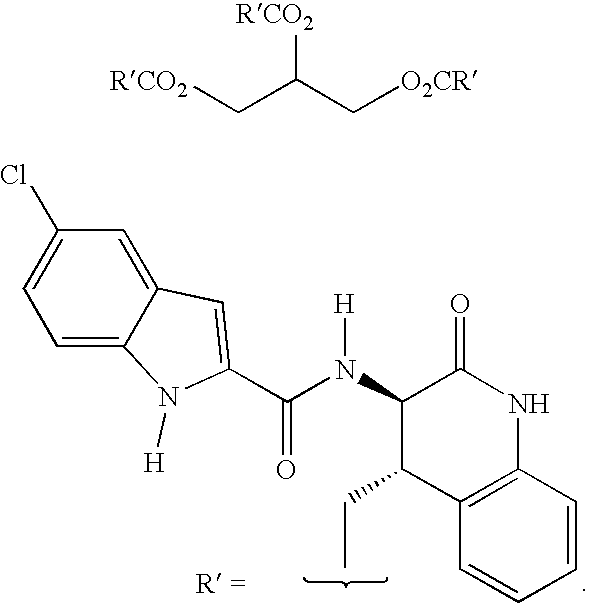Triglyceride and triglyceride-like prodrugs of glycogen phosphorylase inhibiting compounds
a glycogen phosphorylase and prodrug technology, applied in the direction of heterocyclic compound active ingredients, biocide, peptides, etc., can solve the problem of undesirable inhibition of glycogen phosphorylase in tissues outside of the liver, and achieve the effect of minimizing undesired concentrations
- Summary
- Abstract
- Description
- Claims
- Application Information
AI Technical Summary
Benefits of technology
Problems solved by technology
Method used
Image
Examples
example 1
3-(5-chloroindole-2-carbonylamino)-5-methoxy-3,4-dihydrocarbostyril
[0284]Sodium metal (1.15 g) was dissolved in absolute ethanol (500 mL), and to the resulting solution was added diethyl 2-acetylaminomalonate (9.1 g). After 15 min at room temperature, a solution of 2-methoxy-6-nitrobenzyl bromide (J. Med. Chem. 1977, 20, 190–196) (8.6 g) in tetrahydrofuran (25 mL) was added over 2 min. After 16 h stirring at room temperature the mixture was evaporated. The residue was dissolved in a mixture of ethyl acetate and water. The ethyl acetate layer was separated and washed sequentially with water and brine before drying over anhydrous sodium sulfate. Evaporation was followed by silica gel chromatography eluting initially with dichloromethane, followed by ethyl acetate, to obtain diethyl 2-acetylamino-2-(2-methoxy-6-nitrobenzyl)malonate (10.8 g).
[0285]A mixture of diethyl 2-acetylamino-2-(2-methoxy-6-nitrobenzyl)malonate (10.5 g), 10% palladium on carbon (1.0 g), and absolute ethanol (200 m...
example 2
3-(5-chloroindole-2-carbonylamino)-3,4-dihydrocarbostyril
[0289]The title compound was prepared by reaction of the resin bound activated ester with 3-amino-3,4-dihydrocarbostyril (Arch. Biochem. Biophys. 1963, 102, 48–51) according to Resin Capture Procedure. HPLC / MS [M+H]+, 340; [M−H]−, 338.
[0290]Homochiral compounds of the title compound from Example 2 were produced in the following Examples 3 and 4.
example 3
(R)-3-(5-chloroindole-2-carbonylamino)-3,4-dihydrocarbostyril
[0291]Resolution of 3-amino-3,4-dihydrocarbostyril (Arch. Biochem. Biophys. 1963, 102, 48–51) was performed by separating a racemic mixture of 3-amino-3,4-dihydrocarbostyril into its component (R) and (S) enantiomers by chiral normal phase preparative HPLC (Chiralcel AS column, 25% ethanol in hexane). Analysis was by chiral normal phase analytical HPLC (Chiralcel AS column, 30% ethanol in hexane, S isomer elutes before R isomer).
[0292]The title compound was prepared by reaction of the resin bound activated ester with (R)-3-amino-3,4-dihydrocarbostyril according to the Resin Capture Procedure. HPLC / MS [M+H]+, 340; [M−H]−, 338.
PUM
| Property | Measurement | Unit |
|---|---|---|
| temperature | aaaaa | aaaaa |
| pH | aaaaa | aaaaa |
| temperature | aaaaa | aaaaa |
Abstract
Description
Claims
Application Information
 Login to View More
Login to View More - R&D
- Intellectual Property
- Life Sciences
- Materials
- Tech Scout
- Unparalleled Data Quality
- Higher Quality Content
- 60% Fewer Hallucinations
Browse by: Latest US Patents, China's latest patents, Technical Efficacy Thesaurus, Application Domain, Technology Topic, Popular Technical Reports.
© 2025 PatSnap. All rights reserved.Legal|Privacy policy|Modern Slavery Act Transparency Statement|Sitemap|About US| Contact US: help@patsnap.com



